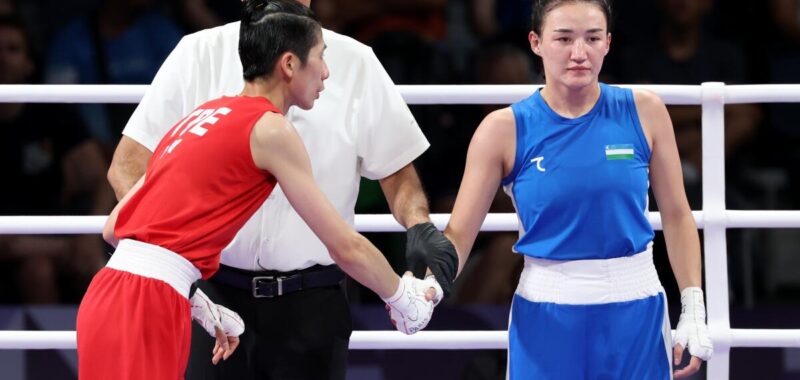
A Summer Olympics that hoped to champion inclusivity — choosing “Games Wide Open” as its slogan — has become embroiled in loud, angry debates over who should and should not be allowed to compete as a woman.
The dispute has triggered conflicting official statements, pointed comments and unhinged social media posts, all whirling around two athletes in the women’s boxing competition at Arena Paris Nord.
This isn’t about how Imane Khelif of Algeria and Lin Yu Ting of Taiwan identify. By all accounts, they were born as women but appear to have unusual body chemistry that triggered gender tests and caused them to be disqualified from last year’s world championships.
The Olympics, however, have broader eligibility rules.
“I think we all have a responsibility to dial down this and not turn it into some kind of witch hunt,” International Olympic Committee spokesman Mark Adams told reporters. “These are regular athletes who have competed for many years in boxing, they are entirely eligible and they are women on their passports.”
His plea has been overshadowed by a Thursday afternoon bout in which Khelif punched an opponent hard enough to make her quit after 46 seconds. Paris has been lumped in the same category as previous controversies involving South African runner Caster Semenya and U.S. collegiate swimmer Lia Thomas.
This case might be more incendiary because, instead of running or swimming fast, Khelif and Lin are delivering potentially lethal blows. Italian boxer Angela Carini said she conceded to Khelif because “I had to safeguard my life.”
Experts wonder if the sports world has reached an inflection point.
“We really have not come up with a consensus on how we define sex,” said Jaime Schultz, author of a new book titled “Regulating Bodies: Elite Sport Policies and Their Unintended Consequences.” “People have to learn how to talk about this.”
Over the last 24 hours, much of the public discourse has inaccurately described Khelif and Lin as transgender. Former President Donald Trump posted on Truth Social: “I WILL KEEP MEN OUT OF WOMEN’S SPORTS!”
There is no evidence that either boxer is transgender or has chromosomal abnormalities. Though purposefully vague, officials have described what appear to be “differences of sex development,” a designation that applies to women who are androgen-sensitive or have naturally occurring testosterone levels in the male range.
The international track federation used this standard to demand that 800-meter star Semenya either take medication to alter her body chemistry or race against men. She fought the decision, losing in the Federal Supreme Court of Switzerland.
Sports have a long and troubled history with gender testing.
Early on, female athletes were forced to disrobe for physical inspections. Chromosome tests came into fashion for a while but were successfully challenged by Spanish runner Maria Jose Martinez-Patino in the 1980s because they could not account for rare conditions.
Though testosterone is now a common measure, there is continued disagreement over its validity.
“These criteria keep folding under the weight of closer scrutiny,” said Schultz, who is also a kinesiology professor at Penn State. “None of them have held up over time.”
Veterans on the amateur scene, Khelif finished fifth in the 60 kilogram event and Lin finished ninth at 57 kilograms in the Tokyo Olympics in 2021. The Algerian won silver at the International Boxing Assn.’s 2022 world championships. The Taiwanese athlete earned gold at that tournament in 2018 and 2022.
But last year, the IBA took action against both women.
Khelif was disqualified shortly before her gold-medal bout and Lin after her bronze-medal victory. The IBA stated the boxers did not “undergo a testosterone examination but were subject to a separate and recognized test, whereby the specifics remain confidential.”
The situation grew more complicated when the IOC suspended its recognition of the IBA after years of dispute between the organizations. With the IOC temporarily in control of boxing at the Games, Khelif and Lin have had their eligibility restored.
It came as no surprise when Khelif’s bout on Thursday prompted dueling responses.
First the IBA condemned Olympic officials for letting Khelif and Lin compete, stating: “We absolutely do not understand why any organization would put a boxer at risk with what could bring a potential serious injury.”
The IOC fired back by saying: “Every person has the right to practice sport without discrimination.” It further noted the IBA disqualifications were “based entirely on this arbitrary decision, which was taken without any proper procedure.”
On Friday morning, when questioned about the Olympics’ apparent struggle with gender rules, Adams said: “There is still neither scientific nor political consensus on this issue. It’s not a black and white issue. And we at the IOC would be very interested to hear of such a solution, such a consensus on this, and we would be the first to act on this should a common understanding be reached.”
Hours later, the media descended on a bout between Lin and Sitora Turdibekova of Uzbekistan. No devastating blows were landed during Lin’s victory, by unanimous decision, after which both athletes walked through the mixed zone without responding to questions.
Khelif’s next bout — against Anna Luca Hamori of Hungary — figures to attract similar attention on Saturday. The Hungarian Boxing Assn. has reportedly protested Khelif’s participation but Hamori did not seem as concerned. “I am not scared,” the boxer said. “If she or he is a man, it will be a bigger victory for me if I win. So let’s do it.”
Even Carini, who fell to her knees and cried after losing to Khelif, has been magnanimous. Her comments reflect the complexity of the issue.
“I am not in the position of saying this is right or wrong,” she told reporters. “I did my job as a boxer, entering the ring and fighting.”

